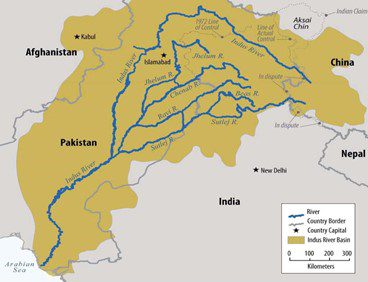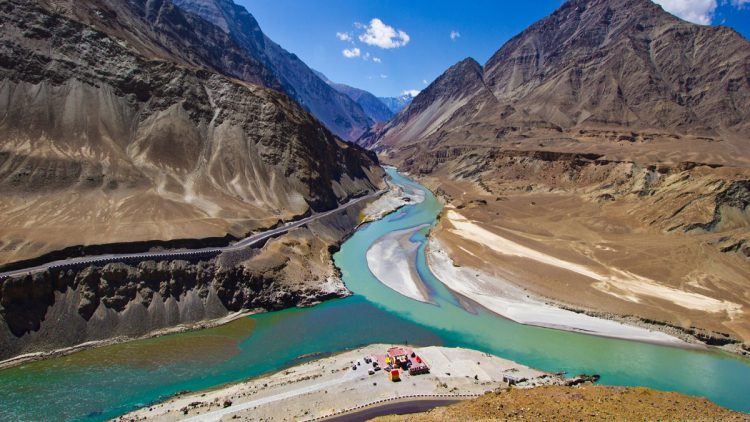Mankind is the major environmental force in changing the geological facade of the Earth. Climate change, a human induced phenomenon, has emerged to be reckoned with as a global reality that can neither be denied nor neglected. The global warming and the melting of glaciers around the world at an alarming rate is its prime evidence. According to the Intergovernmental Panel on Climate Change (IPCC) special report, human activities in the 20th century, have raised the global surface temperature by 0.67⁰C. The rise in temperature has disturbed the weather systems making snow and rainfall regimes uncertain and erratic. This change has disturbed the water balance in river basins particularly where this resource is shared, having transboundary jurisdictions. The climate change has affected the timings, intensity, magnitude, and duration of water flow in snow dominated basins like that of Indus River Basin (IRB). On the one hand, water availability is declining and becoming uncertain, whereas on the other hand water demand is increasing due to increased population growth, urbanization, and industrialization. Uncertainty in the spatial and temporal distribution of water by rains, snow, glaciers, rivers, and aquifers can threaten agriculture production, leading to food insecurity. Crop growing cycles and seasons affected by changing timings and volume of water availability will affect the sowing, growing, maturing, and yield of the crops, which can have profound social and economic impacts creating food crises in the country.
Both parts of the water demand and supply equation are being impacted by climate change. Since the supply side of freshwater is shared, it has implications implicit to transboundary waters. The freshwater sources are exposed to climate change with a high degree of vulnerability. Water has been the most affected element on earth as all its main sources have been adversely impacted. Pakistan, mainly dependent on IRB for its freshwater, is no exception in suffering from the implications of climate change. Pakistan receives about 142 million Acre Feet (MAF) of water as river inflows from glaciers and snow, 50 MAF from rainfall, and approximately 48% of surface water from the aquifer. 92% of available water is used in agriculture, 3% in industries, and 5% for domestic use and infrastructure. Due to socio-economic development and an increase in population, the water demand has increased, exerting pressure on declining water availability. Uncertain conditions for water availability in different parts regarding water quantity, particularly variations in terms of magnitude, timings and duration, have further accentuated the impact of water scarcity. Similarly, the groundwater being a natural reservoir readily available for consumption on the consumer‘s doorstep, has also been adversely impacted due to climate change.
Water, a shared resource, is divided based on availability. Over 300 rivers, 100 lakes and yet to be a determined number of aquifers are shared by two or more countries in the world. The British imperial powers, before decolonizing, partitioned the subcontinent into two independent countries: Pakistan and India, on the 14th and 15th of August 1947, respectively. However, geographical division delineating the borders of newly born states did not cater the hydrological dictates of available water resource. It took about over a decade after the partition that an agreement between both the states was reached for sharing waters of IRB and the Indus Water Treaty (IWT) was signed on 19 September 1960.


IWT is a wholesome agreement between Pakistan and India crafted under the auspices of the World Bank by the collective effort of experts from multiple related fields. The Treaty fixes the jurisdictions of both the countries on different sets of rivers in western and eastern halves by defining the rights and obligations while sharing the water. IWT allocates three eastern rivers (Ravi, Beas and Sutlej) to India, whereas three western rivers (Indus, Jhelum and Chenab) with permission to use some quantity of water by India are allocated to Pakistan. The Treaty has an inbuilt mechanism of information and data sharing, monitoring, and implementation through the Pakistan Indus Water Commission (PIWC). Although the technical, legal, and administrative arrangements of the Treaty are keeping it functional and buoyant, yet its inadequacies create conflictual situations between India and Pakistan when the internal mechanisms of IWT fail to resolve the issues and the doors of international mediators are knocked for the solution. The Treaty has survived tests of tense times for 62 years but now seems to reach a quasi- functional stage due to its inherent voids and concerns developed by both states. The missing contents are termed as ‘voids’ are those elements that Pakistan wants to be part of the treaty. The list of those voids is dominated by the climate change.
When the IWT was framed, the phenomenon of climate change did not exist as it exists now, so it was not incorporated in IWT. The absence of this reality from the Treaty is now negatively affecting IRB and gravely constraining Pakistan as it has only one river basin to draw water from, whereas India has over a dozen river basins to take water. The water quantity with different variables like the volume of water, timings, and duration of its flow and frequency with varying intensity has immensely changed in the last half of a century. As a result, with variation in the quantity of water, water quality has also been negatively impacted. Besides quantity and quality issues, the voids identified during the researches have emerged as serious issues, particularly as the consequence of climate change that needs to be addressed. So, in the face of water variability, incorporating mechanisms to bring flexibility and introducing climate change related clauses and provisions to deal with water quantity and quality issues is the way to retain stability in the Treaty. To incorporate climate change related clauses and provisions for ensuring the sustainability of a IWT is the essence of climate proofing.
The term ‘climate proofing’ a transboundary water agreement means incorporating climate change related clauses and provisions applicable to transboundary waters in the treaty. This further means the way climate change phenomenon is impacting the water resource, should be factored in the treaty for sustainable regulation of water as the consequence of climate change. The process of climate proofing shall provide the flexibility to agreement with which it can adjust to the consequences of climate change. The dominant climate change related factors like equitable and sustainable utilization of water resources and avoiding damage and loss to other riparian states are the most important factors to be incorporated in a treaty. Additionally, different climate change related factors like managing extreme events like drought and floods, maintaining the ecological balance in the basin, management of basin aquifer and groundwater, monitoring and data archiving, data and information sharing, joint institutions for watershed management, amendment and review procedures, dispute resolution and conflict management, etc., if appropriately incorporated in IWT will bring the culture of further cooperation rather than dispute between Pakistan and India. This process will ensure socio-economic, environmental, and political dividends and will also help manage and respond to extreme events like drought and floods. Such mechanisms in the context of agreement will create a culture that shall facilitate the process of cooperation leading to peace and stability in South Asia in general and between Pakistan and India in particular.
The author is an Assistant Professor at the Department of Peace Keeping Training, Centre for International Peace and Stability (CIPS), National University of Sciences & Technology (NUST). He can be reached at fhshah@cips.nust.edu.pk.

![]()





